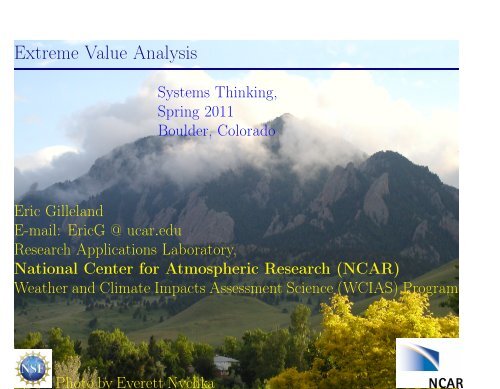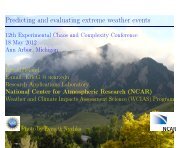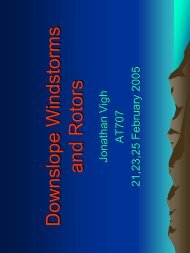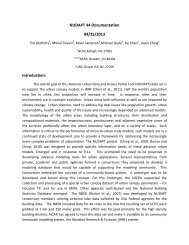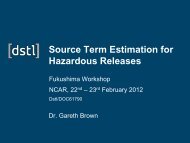Extreme Value Analysis - RAL
Extreme Value Analysis - RAL
Extreme Value Analysis - RAL
Create successful ePaper yourself
Turn your PDF publications into a flip-book with our unique Google optimized e-Paper software.
Photo by Everett Nychka<br />
<strong>Extreme</strong> <strong>Value</strong> <strong>Analysis</strong><br />
Systems Thinking,<br />
Spring 2011<br />
Boulder, Colorado<br />
Eric Gilleland<br />
E-mail: EricG @ ucar.edu<br />
Research Applications Laboratory,<br />
National Center for Atmospheric Research (NCAR)<br />
Weather and Climate Impacts Assessment Science (WCIAS) Program
Motivation<br />
Colorado Lottery
Motivation<br />
Colorado Lottery<br />
Pr{Winning ≥ $10, 000 in one drawing} ≈<br />
0.000001306024
Motivation<br />
Colorado Lottery<br />
Pr{Winning ≥ $10, 000 in one drawing} ≈<br />
0.000001306024<br />
In ten years, playing one ticket<br />
everyday, Pr{Winning ≥ $10, 000} ≈<br />
0.004793062
Motivation<br />
Colorado Lottery<br />
Pr{Winning ≥ $10, 000 in one drawing} ≈<br />
0.000001306024<br />
In ten years, playing one ticket<br />
everyday, Pr{Winning ≥ $10, 000} ≈<br />
0.004793062<br />
In 100 years ≈ 0.05003321<br />
In 1000 years ≈ 0.7686185
Motivation<br />
Colorado Lottery<br />
Pr{Winning ≥ $10, 000 in one drawing} ≈<br />
0.000001306024<br />
In 1000 years ≈ 0.7686185<br />
In ten years, playing one ticket<br />
everyday, Pr{Winning ≥ $10, 000} ≈<br />
0.004793062<br />
In 100 years ≈ 0.05003321<br />
Law of small numbers: events with small probably rarely happen, but<br />
have many opportunities to happen. These follow a<br />
Poisson distribution.
Motivation<br />
Colorado Lottery<br />
Can also talk about waiting time probability. The exponential<br />
distribution models this.
Motivation<br />
Colorado Lottery<br />
Can also talk about waiting time probability. The exponential<br />
distribution models this. For example, the probability that it will<br />
take longer than a year to win the lottery (at one ticket per day) is<br />
≈ 0.999523, longer than ten years ≈ 0.9952411, longer than 500 years<br />
≈ 0.7877987, and so on (decays exponentially, but with a very slow<br />
rate).
Motivation<br />
Colorado Lottery<br />
Another way to put it is that the expected number of years that it<br />
will take to win more than $10,000 in the lottery (buying one ticket<br />
per day) is about 2,096 years. If a ticket costs $1, then we can expect<br />
to spend $765,682.70 before winning at least $10,000.
Motivation<br />
Taleb, N.N. 2010: The Black Swan: The impact of the highly improbable,<br />
Random House, New York, NY, 444 pp.
Outline<br />
• Further motivation for why extremes are of interest, and why they<br />
require careful attention to analyze them.<br />
• Introduce the basics of statistical <strong>Extreme</strong> <strong>Value</strong> <strong>Analysis</strong> (EVA).<br />
• Discuss some limitations for practical applications (climate heavy).<br />
• Introduce the idea of correlation, and why this topic has caused a<br />
lot of controversy regarding the current economic crisis.
Motivation<br />
On the eve of the events in 1914 leading to WWI, would you have<br />
guessed what would happen next?<br />
How about the rise of<br />
Hitler and WWII?<br />
Archduke Franz Ferdinand of Austria<br />
Adolf Hitler
Motivation<br />
The impact of computers?<br />
Spread and impact of the internet?<br />
The stock market crash of 1987, and its surprising recovery?
Motivation<br />
Retrospective Predictability<br />
Different from Prospective Predictability. Once something has happened,<br />
it is easier to trace the steps to find the cause and effect.<br />
Perspective<br />
Insider Trading can lead to an extreme event that is well prospectively<br />
predicted by those on the inside, but if done right, is a surprise to<br />
everyone else (ethics).<br />
Risk<br />
Have you considered extreme events in your risk analysis for your<br />
financial portfolio?
Motivation<br />
Taleb defines a Black Swan event as<br />
• being rare<br />
• having an extreme impact<br />
• being predictable retrospectively, not prospectively.
Motivation<br />
Randomness and Large Deviations<br />
Focus is typically on central tendencies,
Motivation<br />
Randomness and Large Deviations<br />
Focus is typically on central tendencies,
Motivation<br />
Randomness and Large Deviations<br />
Focus is typically on central tendencies,
Motivation<br />
Law of Large Numbers, Sum Stability, Central Limit Theorem<br />
And other results give theoretical support for use of the<br />
Normal distribution for analyzing most data.
Motivation<br />
Law of Large Numbers, Sum Stability, Central Limit Theorem<br />
And other results give theoretical support for use of the<br />
Normal distribution for analyzing most data.<br />
But, it is the possible<br />
extreme (or rare) events that<br />
are the most influencial.
Background<br />
Extremal Types Theorem<br />
Theoretical support for using the <strong>Extreme</strong> <strong>Value</strong> Distributions<br />
(EVD’s) for extrema.<br />
• Valid for maxima over very large blocks, or<br />
• Excesses over a very high threshold.<br />
It is possible that there is no appropriate distribution for extremes,<br />
but if there is one, it must be from the Generalized <strong>Extreme</strong> <strong>Value</strong><br />
(GEV) family (block maxima) or the Generalized Pareto (GP) family<br />
(excesses over a high threshold). The two families are related.
Background<br />
Extremal Types Theorem<br />
Theoretical support for using the <strong>Extreme</strong> <strong>Value</strong> Distributions<br />
(EVD’s) for extrema.<br />
• Valid for maxima over very large blocks, or<br />
• Excesses over a very high threshold.<br />
It is possible that there is no appropriate distribution for extremes,<br />
but if there is one, it must be from the Generalized <strong>Extreme</strong> <strong>Value</strong><br />
(GEV) family (block maxima) or the Generalized Pareto (GP) family<br />
(excesses over a high threshold). The two families are related.<br />
Poisson process allows for a nice characterization of the threshold<br />
excess model that neatly ties it back to the GEV distribution.
Background<br />
Simulated Maxima
Background<br />
GEV<br />
Three parameters: location, scale and shape.<br />
{ [ ( )] } −1/ξ z − µ<br />
Pr{X ≤ z} = exp − 1 + ξ<br />
σ
Background<br />
GEV<br />
Three parameters: location, scale and shape.<br />
{ [ ( )] } −1/ξ z − µ<br />
Pr{X ≤ z} = exp − 1 + ξ<br />
σ<br />
Three types of tail behavior:<br />
1. Bounded upper tail (ξ < 0, Weibull),<br />
2. light tail (ξ = 0, Gumbel), and<br />
3. heavy tail (ξ > 0, Fréchet).
Background<br />
Weibull Type<br />
Bounded upper tail is a function of parameters. Namely, µ − σ/ξ.<br />
ξ < 0<br />
Temperature, Wind Speed,<br />
Sea Level
Background<br />
Weibull Type<br />
Predicted Speed Limits for:<br />
Thoroughbreds (Kentucky Derby) ≈ 38 mph<br />
Greyhounds (English Derby) ≈ 38 mph<br />
Men (100 m distance) ≈ 24 mph<br />
Women (100 m distance) ≈ 22 mph<br />
Men (10 km distance) ≈ 15 mph<br />
Women (marathon distance) ≈ 12 mph<br />
Women (marathon distance, population model)<br />
≈ 11.45 mph<br />
Paula Radcliffe, 11.6 mph world marathon record<br />
Denny, M.W., 2008: Limits to running speed in dogs, horses and<br />
humans. J. Experim. Biol., 211:3836–3849.
Background<br />
Gumbel Type<br />
Light-tailed distribution (i.e., decays exponentially)<br />
ξ = 0<br />
Domain of attraction for many<br />
common distributions<br />
(e.g., the normal distribution)
Background<br />
Gumbel Type<br />
Light-tailed distribution (i.e., decays exponentially)<br />
ξ = 0<br />
Domain of attraction for many<br />
common distributions<br />
(e.g., the normal distribution)<br />
Single point in a continuous parameter space!
Background<br />
Fréchet Type<br />
Heavy-tailed distribution (i.e., decays polynomially)<br />
Bounded lower tail at µ − σ/ξ.<br />
ξ > 0<br />
Precipitation, Stream Flow,<br />
Economic Impacts
Background<br />
Fréchet Type<br />
Heavy-tailed distribution (i.e., decays polynomially)<br />
Bounded lower tail at µ − σ/ξ.<br />
ξ > 0<br />
Precipitation, Stream Flow,<br />
Economic Impacts<br />
Infinite mean if ξ ≥ 1!<br />
Infinite variance if ξ ≥ 1/2!
Background<br />
All three types together
Background<br />
Analogous for Peaks Over a Threshold (POT) approach<br />
Generalized Pareto Distribution (GPD), which has two parameters:<br />
scale and shape. Threshold replaces the location parameter.<br />
Three Types:<br />
1. Beta (ξ < 0), bounded above at threshold−σ/ξ<br />
2. Exponential (ξ = 0), light tail<br />
3. Pareto (ξ > 0), heavy tail
Background<br />
Minima<br />
Same as maxima using the relation:<br />
min{X 1 , . . . , X n } = − max{−X 1 , . . . , −X n }
Background<br />
Minima<br />
Same as maxima using the relation:<br />
min{X 1 , . . . , X n } = − max{−X 1 , . . . , −X n }<br />
Analogous for POT approach: Look at negatives of deficits under a<br />
threshold instead of excesses over a threshold.
Background<br />
Block Maxima vs. POT
Background<br />
Block Maxima vs. POT
Background<br />
Block Maxima vs. POT
Examples<br />
Fort Collins, Colorado<br />
daily precipitation amount<br />
• Time series of daily precipitation<br />
amount (inches), 1900–1999.<br />
• Semi-arid region.<br />
• Marked annual cycle in precipitation<br />
(wettest in late spring/early summer,<br />
driest in winter).<br />
• No obvious long-term trend.<br />
• Recent flood, 28 July 1997.<br />
(substantial damage to<br />
Colorado State University)<br />
http://ccc.atmos.colostate.edu/~odie/rain.html
Examples<br />
Fort Collins, Colorado precipitation
Examples<br />
Fort Collins, Colorado Annual Maximum Precipitation<br />
How often is such an<br />
extreme expected?
Examples<br />
Fort Collins, Colorado precipitation<br />
Gumbel hypothesis rejected at 5% level.<br />
ξ ≈ 0.17, 95% CI ≈ (0.01, 0.37)<br />
Fréchet (heavy tail)
Examples<br />
Fort Collins, Colorado precipitation<br />
Risk Communication
Examples<br />
Fort Collins, Colorado precipitation<br />
Risk Communication<br />
Easy to invert GEV distribution to get quantiles, which for<br />
block maxima are Return Levels.
Examples<br />
Fort Collins, Colorado precipitation<br />
Risk Communication<br />
Easy to invert GEV distribution to get quantiles, which for<br />
block maxima are Return Levels.<br />
The return level is the value expected to be<br />
exceeded on average once every 1/p years.
Examples<br />
Fort Collins, Colorado precipitation<br />
Risk Communication<br />
For 1/p = 10 years, the return level is ≈ 2.8 inches with<br />
95% CI ≈ (2.4, 3.2) inches.<br />
For 1/p = 100 years, the return level is ≈ 5.1 inches<br />
with 95% CI ≈ (3.4, 6.8) inches.
Examples<br />
Fort Collins, Colorado precipitation<br />
Risk Communication<br />
Pr{annual max. precip. ≥ 3 inches} ≈ 0.08<br />
That is, the return period for 3 inches<br />
of accumulated rainfall at this gauge<br />
in Fort Collins is estimated to be<br />
about 12.5 years.
Examples<br />
Fort Collins, Colorado precipitation<br />
Can also obtain other information, such as<br />
• Mean annual maximum daily precipitation accumulation ≈ 1.76<br />
inches (≠ ˆµ ≈ 1.35).<br />
• Variance is ≈ 0.84 inches 2 .<br />
• Standard deviation is ≈ 0.92 inches (≠ ˆσ ≈ 0.53).
Background
Examples<br />
Hurricane damage<br />
Economic Damage from Hurricanes (1925−1995)<br />
●<br />
Economic damage caused<br />
by hurricanes from 1926<br />
to 1995.<br />
billion US$<br />
0 20 40 60<br />
●<br />
●<br />
●<br />
● ●<br />
● ●<br />
●<br />
● ●<br />
● ●<br />
●<br />
● ● ●<br />
●<br />
●<br />
●● ●● ● ● ●●● ● ● ● ●●<br />
●●● ● ● ● ● ●<br />
●<br />
●●●<br />
●<br />
● ●● ●●●●●<br />
●●●<br />
● ●●●● ● ●●●● ● ●<br />
●● ●● ●● ● ●●●● ●●<br />
●●●●<br />
● ●<br />
Trends in societal<br />
vulnerability removed.<br />
Excess over threshold of<br />
u = 6 billion US$.<br />
1930 1940 1950 1960 1970 1980 1990<br />
Year
Examples<br />
Hurricane damage<br />
GPD<br />
pdf<br />
0.00 0.05 0.10 0.15 0.20<br />
ˆσ ≈ 4.589<br />
ˆξ ≈ 0.512<br />
10 20 30 40 50 60 70<br />
95% CI for shape<br />
parameter using<br />
profile likelihood.<br />
≈ (0.05, 1.56)<br />
Heavy tail!
Examples<br />
Hurricane Dennis (2005)<br />
Caused at least 89 deaths and<br />
2.23 billion USD in damage.<br />
Impactful despite being under the 6 billion USD threshold!
Examples<br />
Phoenix (airport) minimum temperature ( o F)<br />
●<br />
●<br />
●<br />
●<br />
●<br />
●<br />
●<br />
●<br />
●<br />
●<br />
●<br />
●<br />
●<br />
●<br />
●<br />
●<br />
●<br />
●<br />
●<br />
●<br />
●<br />
●<br />
●<br />
●<br />
●<br />
●<br />
●<br />
●<br />
●<br />
●<br />
●<br />
●<br />
●<br />
●<br />
●<br />
●<br />
●<br />
●<br />
●<br />
●<br />
●<br />
●<br />
●<br />
●<br />
●<br />
●<br />
●<br />
●<br />
●<br />
●<br />
●<br />
●<br />
●<br />
●<br />
●<br />
●<br />
●<br />
●<br />
●<br />
●<br />
●<br />
●<br />
●<br />
●<br />
●<br />
●<br />
●<br />
●<br />
●<br />
●<br />
●<br />
●<br />
●<br />
●<br />
●<br />
●<br />
●<br />
●<br />
●<br />
●<br />
●<br />
●<br />
●<br />
●<br />
●<br />
●<br />
●<br />
●<br />
●<br />
●<br />
●<br />
●<br />
●<br />
●<br />
●<br />
●<br />
●<br />
●<br />
●<br />
●<br />
●<br />
●<br />
●<br />
●<br />
●<br />
●<br />
●<br />
●<br />
●<br />
●<br />
●<br />
●<br />
●<br />
●<br />
●<br />
●<br />
●<br />
●<br />
●<br />
●<br />
●<br />
●<br />
●<br />
●<br />
●<br />
●<br />
●<br />
●<br />
●<br />
●<br />
●<br />
●<br />
●<br />
●<br />
●<br />
●<br />
●<br />
●<br />
●<br />
●<br />
●<br />
●<br />
●<br />
●<br />
●<br />
●<br />
●<br />
●<br />
●<br />
●<br />
●<br />
●<br />
●<br />
●<br />
●<br />
●<br />
●<br />
●<br />
●<br />
●<br />
●<br />
●<br />
●<br />
●<br />
●<br />
●<br />
●<br />
●<br />
●<br />
●<br />
●<br />
●<br />
●<br />
●<br />
●<br />
●<br />
●<br />
●<br />
●<br />
●<br />
●<br />
●<br />
●<br />
●<br />
●<br />
●<br />
●<br />
●<br />
●<br />
●<br />
●<br />
●<br />
●<br />
●<br />
●<br />
●<br />
●<br />
●<br />
●<br />
●<br />
●<br />
●<br />
●<br />
●<br />
●<br />
●<br />
●<br />
●<br />
●<br />
●<br />
●<br />
●<br />
●<br />
●<br />
●<br />
●<br />
●<br />
●<br />
●<br />
●<br />
●<br />
●<br />
●<br />
●<br />
●<br />
●<br />
●<br />
●<br />
●<br />
●<br />
●<br />
●<br />
●<br />
●<br />
●<br />
●<br />
●<br />
●<br />
●<br />
●<br />
●<br />
●<br />
●<br />
●<br />
●<br />
●<br />
●<br />
●<br />
●<br />
●<br />
●<br />
●<br />
●<br />
●<br />
●<br />
●<br />
●<br />
●<br />
●<br />
●<br />
●<br />
●<br />
●<br />
●<br />
●<br />
●<br />
●<br />
●<br />
●<br />
●<br />
●<br />
●<br />
●<br />
●<br />
●<br />
●<br />
●<br />
●<br />
●<br />
●<br />
●<br />
●<br />
●<br />
●<br />
●<br />
●<br />
●<br />
●<br />
●<br />
●<br />
●<br />
●<br />
●<br />
●<br />
●<br />
●<br />
●<br />
●<br />
●<br />
●<br />
●<br />
●<br />
●<br />
●<br />
●<br />
●<br />
●<br />
●<br />
●<br />
●<br />
●<br />
●<br />
●<br />
●<br />
●<br />
●<br />
●<br />
●<br />
●<br />
●<br />
●<br />
●<br />
●<br />
●<br />
●<br />
●<br />
●<br />
●<br />
●<br />
●<br />
●<br />
●<br />
●<br />
●<br />
●<br />
●<br />
●<br />
●<br />
●<br />
●<br />
●<br />
●<br />
●<br />
●<br />
●<br />
●<br />
●<br />
●<br />
●<br />
●<br />
●<br />
●<br />
●<br />
●<br />
●<br />
●<br />
●<br />
●<br />
●<br />
●<br />
●<br />
●<br />
●<br />
●<br />
●<br />
●<br />
●<br />
●<br />
●<br />
●<br />
●<br />
●<br />
●<br />
●<br />
●<br />
●<br />
●<br />
●<br />
●<br />
●<br />
●<br />
●<br />
●<br />
●<br />
●<br />
●<br />
●<br />
●<br />
●<br />
●<br />
●<br />
●<br />
●<br />
●<br />
●<br />
●<br />
●<br />
●<br />
●<br />
●<br />
●<br />
●<br />
●<br />
●<br />
●<br />
●<br />
●<br />
●<br />
●<br />
●<br />
●<br />
●<br />
●<br />
●<br />
●<br />
●<br />
●<br />
●<br />
●<br />
●<br />
●<br />
●<br />
●<br />
●<br />
●<br />
●<br />
●<br />
●<br />
●<br />
●<br />
●<br />
●<br />
●<br />
●<br />
●<br />
●<br />
●<br />
●<br />
●<br />
●<br />
●<br />
●<br />
●<br />
●<br />
●<br />
●<br />
●<br />
●<br />
●<br />
●<br />
●<br />
●<br />
●<br />
●<br />
●<br />
●<br />
●<br />
●<br />
●<br />
●<br />
●<br />
●<br />
●<br />
●<br />
●<br />
●<br />
●<br />
●<br />
●<br />
●<br />
●<br />
●<br />
●<br />
●<br />
●<br />
●<br />
●<br />
●<br />
●<br />
●<br />
●<br />
●<br />
●<br />
●<br />
●<br />
●<br />
●<br />
●<br />
●<br />
●<br />
●<br />
●<br />
●<br />
●<br />
●<br />
●<br />
●<br />
●<br />
●<br />
●<br />
●<br />
●<br />
●<br />
●<br />
●<br />
●<br />
●<br />
●<br />
●<br />
●<br />
●<br />
●<br />
●<br />
●<br />
●<br />
●<br />
●<br />
●<br />
●<br />
●<br />
●<br />
●<br />
●<br />
●<br />
●<br />
●<br />
●<br />
●<br />
●<br />
●<br />
●<br />
●<br />
●<br />
●<br />
●<br />
●<br />
●<br />
●<br />
●<br />
●<br />
●<br />
●<br />
●<br />
●<br />
●<br />
●<br />
●<br />
●<br />
●<br />
●<br />
●<br />
●<br />
●<br />
●<br />
●<br />
●<br />
●<br />
●<br />
●<br />
●<br />
●<br />
●<br />
●<br />
●<br />
●<br />
●<br />
●<br />
●<br />
●<br />
●<br />
●<br />
●<br />
●<br />
●<br />
●<br />
●<br />
●<br />
●<br />
●<br />
●<br />
●<br />
●<br />
●<br />
●<br />
●<br />
●<br />
●<br />
●<br />
●<br />
●<br />
●<br />
●<br />
●<br />
●<br />
●<br />
●<br />
●<br />
●<br />
●<br />
●<br />
●<br />
●<br />
●<br />
●<br />
●<br />
●<br />
●<br />
●<br />
●<br />
●<br />
●<br />
●<br />
●<br />
●<br />
●<br />
●<br />
●<br />
●<br />
●<br />
●<br />
●<br />
●<br />
●<br />
●<br />
●<br />
●<br />
●<br />
●<br />
●<br />
●<br />
●<br />
●<br />
●<br />
●<br />
●<br />
●<br />
●<br />
●<br />
●<br />
●<br />
●<br />
●<br />
●<br />
●<br />
●<br />
●<br />
●<br />
●<br />
●<br />
●<br />
●<br />
●<br />
●<br />
●<br />
●<br />
●<br />
●<br />
●<br />
●<br />
●<br />
●<br />
●<br />
●<br />
●<br />
●<br />
●<br />
●<br />
●<br />
●<br />
●<br />
●<br />
●<br />
●<br />
●<br />
●<br />
●<br />
●<br />
●<br />
●<br />
●<br />
●<br />
●<br />
●<br />
●<br />
●<br />
●<br />
●<br />
●<br />
●<br />
●<br />
●<br />
●<br />
●<br />
●<br />
●<br />
●<br />
●<br />
●<br />
●<br />
●<br />
●<br />
●<br />
●<br />
●<br />
●<br />
●<br />
●<br />
●<br />
●<br />
●<br />
●<br />
●<br />
●<br />
●<br />
●<br />
●<br />
●<br />
●<br />
●<br />
●<br />
●<br />
●<br />
●<br />
●<br />
●<br />
●<br />
●<br />
●<br />
●<br />
●<br />
●<br />
●<br />
●<br />
●<br />
●<br />
●<br />
●<br />
●<br />
●<br />
●<br />
●<br />
●<br />
●<br />
●<br />
●<br />
●<br />
●<br />
●<br />
●<br />
●<br />
●<br />
●<br />
●<br />
●<br />
●<br />
●<br />
●<br />
●<br />
●<br />
●<br />
●<br />
●<br />
●<br />
●<br />
●<br />
●<br />
●<br />
●<br />
●<br />
●<br />
●<br />
●<br />
●<br />
●<br />
●<br />
●<br />
●<br />
●<br />
●<br />
●<br />
●<br />
●<br />
●<br />
●<br />
●<br />
●<br />
●<br />
●<br />
●<br />
●<br />
●<br />
●<br />
●<br />
●<br />
●<br />
●<br />
●<br />
●<br />
●<br />
●<br />
●<br />
●<br />
●<br />
●<br />
●<br />
●<br />
●<br />
●<br />
●<br />
●<br />
●<br />
●<br />
●<br />
●<br />
●<br />
●<br />
●<br />
●<br />
●<br />
●<br />
●<br />
●<br />
●<br />
●<br />
●<br />
●<br />
●<br />
●<br />
●<br />
●<br />
●<br />
●<br />
●<br />
●<br />
●<br />
●<br />
●<br />
●<br />
●<br />
●<br />
●<br />
●<br />
●<br />
●<br />
●<br />
●<br />
●<br />
●<br />
●<br />
●<br />
●<br />
●<br />
●<br />
●<br />
●<br />
●<br />
●<br />
●<br />
●<br />
●<br />
●<br />
●<br />
●<br />
●<br />
●<br />
●<br />
●<br />
●<br />
●<br />
●<br />
●<br />
●<br />
●<br />
●<br />
●<br />
●<br />
●<br />
●<br />
●<br />
●<br />
●<br />
●<br />
●<br />
●<br />
●<br />
●<br />
●<br />
●<br />
●<br />
●<br />
●<br />
●<br />
●<br />
●<br />
●<br />
●<br />
●<br />
●<br />
●<br />
●<br />
●<br />
●<br />
●<br />
●<br />
●<br />
●<br />
●<br />
●<br />
●<br />
●<br />
●<br />
●<br />
●<br />
●<br />
●<br />
●<br />
●<br />
●<br />
●<br />
●<br />
●<br />
●<br />
●<br />
●<br />
●<br />
●<br />
●<br />
●<br />
●<br />
●<br />
●<br />
●<br />
●<br />
●<br />
●<br />
●<br />
●<br />
●<br />
●<br />
●<br />
●<br />
●<br />
●<br />
●<br />
●<br />
●<br />
●<br />
●<br />
●<br />
●<br />
●<br />
●<br />
●<br />
●<br />
●<br />
●<br />
●<br />
●<br />
●<br />
●<br />
●<br />
●<br />
●<br />
●<br />
●<br />
●<br />
●<br />
●<br />
●<br />
●<br />
●<br />
●<br />
●<br />
●<br />
●<br />
●<br />
●<br />
●<br />
●<br />
●<br />
●<br />
●<br />
●<br />
●<br />
●<br />
●<br />
●<br />
●<br />
●<br />
●<br />
●<br />
●<br />
●<br />
●<br />
●<br />
●<br />
●<br />
●<br />
●<br />
●<br />
●<br />
●<br />
●<br />
●<br />
●<br />
●<br />
●<br />
●<br />
●<br />
●<br />
●<br />
●<br />
●<br />
●<br />
●<br />
●<br />
●<br />
●<br />
●<br />
●<br />
●<br />
●<br />
●<br />
●<br />
●<br />
●<br />
●<br />
●<br />
●<br />
●<br />
●<br />
●<br />
●<br />
●<br />
●<br />
●<br />
●<br />
●<br />
●<br />
●<br />
●<br />
●<br />
●<br />
●<br />
●<br />
●<br />
●<br />
●<br />
●<br />
●<br />
●<br />
●<br />
●<br />
●<br />
●<br />
●<br />
●<br />
●<br />
●<br />
●<br />
●<br />
●<br />
●<br />
●<br />
●<br />
●<br />
●<br />
●<br />
●<br />
●<br />
●<br />
●<br />
●<br />
●<br />
●<br />
●<br />
●<br />
●<br />
●<br />
●<br />
●<br />
●<br />
●<br />
●<br />
●<br />
●<br />
●<br />
●<br />
●<br />
●<br />
●<br />
●<br />
●<br />
●<br />
●<br />
●<br />
●<br />
●<br />
●<br />
●<br />
●<br />
●<br />
●<br />
●<br />
●<br />
●<br />
●<br />
●<br />
●<br />
●<br />
●<br />
●<br />
●<br />
●<br />
●<br />
●<br />
●<br />
●<br />
●<br />
●<br />
●<br />
●<br />
●<br />
●<br />
●<br />
●<br />
●<br />
●<br />
●<br />
●<br />
●<br />
●<br />
●<br />
●<br />
●<br />
●<br />
●<br />
●<br />
●<br />
●<br />
●<br />
●<br />
●<br />
●<br />
●<br />
●<br />
●<br />
●<br />
●<br />
●<br />
●<br />
●<br />
●<br />
●<br />
●<br />
●<br />
●<br />
●<br />
●<br />
●<br />
●<br />
●<br />
●<br />
●<br />
●<br />
●<br />
●<br />
●<br />
●<br />
●<br />
●<br />
●<br />
●<br />
●<br />
●<br />
●<br />
●<br />
●<br />
●<br />
●<br />
●<br />
●<br />
●<br />
●<br />
●<br />
●<br />
●<br />
●<br />
●<br />
●<br />
●<br />
●<br />
●<br />
●<br />
●<br />
●<br />
●<br />
●<br />
●<br />
●<br />
●<br />
●<br />
●<br />
●<br />
●<br />
●<br />
●<br />
●<br />
●<br />
●<br />
●<br />
●<br />
●<br />
●<br />
●<br />
●<br />
●<br />
●<br />
●<br />
●<br />
●<br />
●<br />
●<br />
●<br />
●<br />
●<br />
●<br />
●<br />
●<br />
●<br />
●<br />
●<br />
●<br />
●<br />
●<br />
●<br />
●<br />
●<br />
●<br />
●<br />
●<br />
●<br />
●<br />
●<br />
●<br />
●<br />
●<br />
●<br />
●<br />
●<br />
●<br />
●<br />
●<br />
●<br />
●<br />
●<br />
●<br />
●<br />
●<br />
●<br />
●<br />
●<br />
●<br />
●<br />
●<br />
●<br />
●<br />
●<br />
●<br />
●<br />
●<br />
●<br />
●<br />
●<br />
●<br />
●<br />
●<br />
●<br />
●<br />
●<br />
●<br />
●<br />
●<br />
●<br />
●<br />
●<br />
●<br />
●<br />
●<br />
●<br />
●<br />
●<br />
●<br />
●<br />
●<br />
●<br />
●<br />
●<br />
●<br />
●<br />
●<br />
●<br />
●<br />
●<br />
●<br />
●<br />
●<br />
●<br />
●<br />
●<br />
●<br />
●<br />
●<br />
●<br />
●<br />
●<br />
●<br />
●<br />
●<br />
●<br />
●<br />
●<br />
●<br />
●<br />
●<br />
●<br />
●<br />
●<br />
●<br />
●<br />
●<br />
●<br />
●<br />
●<br />
●<br />
●<br />
●<br />
●<br />
●<br />
●<br />
●<br />
●<br />
●<br />
●<br />
●<br />
●<br />
●<br />
●<br />
●<br />
●<br />
●<br />
●<br />
●<br />
●<br />
●<br />
●<br />
●<br />
●<br />
●<br />
●<br />
●<br />
●<br />
●<br />
●<br />
●<br />
●<br />
●<br />
●<br />
●<br />
●<br />
●<br />
●<br />
●<br />
●<br />
●<br />
●<br />
●<br />
●<br />
●<br />
●<br />
●<br />
●<br />
●<br />
●<br />
●<br />
●<br />
●<br />
●<br />
●<br />
●<br />
●<br />
●<br />
●<br />
●<br />
●<br />
●<br />
●<br />
●<br />
●<br />
●<br />
●<br />
●<br />
●<br />
●<br />
●<br />
●<br />
●<br />
●<br />
●<br />
●<br />
●<br />
●<br />
●<br />
●<br />
●<br />
●<br />
●<br />
●<br />
●<br />
●<br />
●<br />
●<br />
●<br />
●<br />
●<br />
●<br />
●<br />
●<br />
●<br />
●<br />
●<br />
●<br />
●<br />
●<br />
●<br />
●<br />
●<br />
●<br />
●<br />
●<br />
●<br />
●<br />
●<br />
●<br />
●<br />
●<br />
●<br />
●<br />
●<br />
●<br />
●<br />
●<br />
●<br />
●<br />
●<br />
●<br />
●<br />
●<br />
●<br />
●<br />
●<br />
●<br />
●<br />
●<br />
●<br />
●<br />
●<br />
●<br />
●<br />
●<br />
●<br />
●<br />
●<br />
●<br />
●<br />
●<br />
●<br />
●<br />
●<br />
●<br />
●<br />
●<br />
●<br />
●<br />
●<br />
●<br />
●<br />
●<br />
●<br />
●<br />
●<br />
●<br />
●<br />
●<br />
●<br />
●<br />
●<br />
●<br />
●<br />
●<br />
●<br />
●<br />
●<br />
●<br />
●<br />
●<br />
●<br />
●<br />
●<br />
●<br />
●<br />
●<br />
●<br />
●<br />
●<br />
●<br />
●<br />
●<br />
●<br />
●<br />
●<br />
●<br />
●<br />
●<br />
●<br />
●<br />
●<br />
●<br />
●<br />
●<br />
●<br />
●<br />
●<br />
●<br />
●<br />
●<br />
●<br />
●<br />
●<br />
●<br />
●<br />
●<br />
●<br />
●<br />
●<br />
●<br />
●<br />
●<br />
●<br />
●<br />
●<br />
●<br />
●<br />
●<br />
●<br />
●<br />
●<br />
●<br />
●<br />
●<br />
●<br />
●<br />
●<br />
●<br />
●<br />
●<br />
●<br />
●<br />
●<br />
●<br />
●<br />
●<br />
●<br />
●<br />
●<br />
●<br />
●<br />
●<br />
●<br />
●<br />
●<br />
●<br />
●<br />
●<br />
●<br />
●<br />
●<br />
●<br />
●<br />
●<br />
●<br />
●<br />
●<br />
●<br />
●<br />
●<br />
●<br />
●<br />
●<br />
●<br />
●<br />
●<br />
●<br />
●<br />
●<br />
●<br />
●<br />
●<br />
●<br />
●<br />
●<br />
●<br />
●<br />
●<br />
●<br />
●<br />
●<br />
●<br />
●<br />
●<br />
●<br />
●<br />
●<br />
●<br />
●<br />
●<br />
●<br />
●<br />
●<br />
●<br />
●<br />
●<br />
●<br />
●<br />
●<br />
●<br />
●<br />
●<br />
●<br />
●<br />
●<br />
●<br />
●<br />
●<br />
●<br />
●<br />
●<br />
●<br />
●<br />
●<br />
●<br />
●<br />
●<br />
●<br />
●<br />
●<br />
●<br />
●<br />
●<br />
●<br />
●<br />
●<br />
●<br />
●<br />
●<br />
●<br />
●<br />
●<br />
●<br />
●<br />
●<br />
●<br />
●<br />
●<br />
●<br />
●<br />
●<br />
●<br />
●<br />
●<br />
●<br />
●<br />
●<br />
●<br />
●<br />
●<br />
●<br />
●<br />
●<br />
●<br />
●<br />
●<br />
●<br />
●<br />
●<br />
●<br />
●<br />
●<br />
●<br />
●<br />
●<br />
●<br />
●<br />
●<br />
●<br />
●<br />
●<br />
●<br />
●<br />
●<br />
●<br />
●<br />
●<br />
●<br />
●<br />
●<br />
●<br />
●<br />
●<br />
●<br />
●<br />
●<br />
●<br />
●<br />
●<br />
●<br />
●<br />
●<br />
●<br />
●<br />
●<br />
●<br />
●<br />
●<br />
●<br />
●<br />
●<br />
●<br />
●<br />
●<br />
●<br />
●<br />
●<br />
●<br />
●<br />
●<br />
●<br />
●<br />
●<br />
●<br />
●<br />
●<br />
●<br />
●<br />
●<br />
●<br />
●<br />
●<br />
●<br />
●<br />
●<br />
●<br />
●<br />
●<br />
●<br />
●<br />
●<br />
●<br />
●<br />
●<br />
●<br />
●<br />
●<br />
●<br />
●<br />
●<br />
●<br />
●<br />
●<br />
●<br />
●<br />
●<br />
●<br />
●<br />
●<br />
●<br />
●<br />
●<br />
●<br />
●<br />
●<br />
●<br />
●<br />
●<br />
●<br />
●<br />
●<br />
●<br />
●<br />
●<br />
●<br />
●<br />
●<br />
●<br />
●<br />
●<br />
●<br />
●<br />
●<br />
●<br />
●<br />
●<br />
●<br />
●<br />
●<br />
●<br />
●<br />
●<br />
●<br />
●<br />
●<br />
●<br />
●<br />
●<br />
●<br />
●<br />
●<br />
●<br />
●<br />
●<br />
●<br />
●<br />
●<br />
●<br />
●<br />
●<br />
●<br />
●<br />
●<br />
●<br />
●<br />
●<br />
●<br />
●<br />
●<br />
●<br />
●<br />
●<br />
●<br />
●<br />
●<br />
●<br />
●<br />
●<br />
●<br />
●<br />
●<br />
●<br />
●<br />
●<br />
●<br />
●<br />
●<br />
●<br />
●<br />
●<br />
●<br />
●<br />
●<br />
●<br />
●<br />
●<br />
●<br />
●<br />
●<br />
●<br />
●<br />
●<br />
●<br />
●<br />
●<br />
●<br />
●<br />
●<br />
●<br />
●<br />
●<br />
●<br />
●<br />
●<br />
●<br />
●<br />
●<br />
●<br />
●<br />
●<br />
●<br />
●<br />
●<br />
●<br />
●<br />
●<br />
●<br />
●<br />
●<br />
●<br />
●<br />
●<br />
●<br />
●<br />
●<br />
●<br />
●<br />
●<br />
●<br />
●<br />
●<br />
●<br />
●<br />
●<br />
●<br />
●<br />
●<br />
●<br />
●<br />
●<br />
●<br />
●<br />
●<br />
●<br />
●<br />
●<br />
●<br />
●<br />
●<br />
●<br />
●<br />
●<br />
●<br />
●<br />
●<br />
●<br />
●<br />
●<br />
●<br />
●<br />
●<br />
●<br />
●<br />
●<br />
●<br />
●<br />
●<br />
●<br />
●<br />
●<br />
●<br />
●<br />
●<br />
●<br />
●<br />
●<br />
●<br />
●<br />
●<br />
●<br />
●<br />
●<br />
●<br />
●<br />
●<br />
●<br />
●<br />
●<br />
●<br />
●<br />
●<br />
●<br />
●<br />
●<br />
●<br />
●<br />
●<br />
●<br />
●<br />
●<br />
●<br />
●<br />
●<br />
●<br />
●<br />
●<br />
●<br />
●<br />
●<br />
●<br />
●<br />
●<br />
●<br />
●<br />
●<br />
●<br />
●<br />
●<br />
●<br />
●<br />
●<br />
●<br />
●<br />
●<br />
●<br />
●<br />
●<br />
●<br />
●<br />
●<br />
●<br />
●<br />
●<br />
●<br />
●<br />
●<br />
●<br />
●<br />
●<br />
●<br />
●<br />
●<br />
●<br />
●<br />
●<br />
●<br />
●<br />
●<br />
●<br />
●<br />
●<br />
●<br />
●<br />
●<br />
●<br />
●<br />
●<br />
●<br />
●<br />
●<br />
●<br />
●<br />
●<br />
●<br />
●<br />
●<br />
●<br />
●<br />
●<br />
●<br />
●<br />
●<br />
●<br />
●<br />
●<br />
●<br />
●<br />
●<br />
●<br />
●<br />
●<br />
●<br />
●<br />
●<br />
●<br />
●<br />
●<br />
●<br />
●<br />
●<br />
●<br />
●<br />
●<br />
●<br />
●<br />
●<br />
●<br />
●<br />
●<br />
●<br />
●<br />
●<br />
●<br />
●<br />
●<br />
●<br />
●<br />
●<br />
●<br />
●<br />
●<br />
●<br />
●<br />
●<br />
●<br />
●<br />
●<br />
●<br />
●<br />
●<br />
●<br />
●<br />
●<br />
●<br />
●<br />
●<br />
●<br />
●<br />
●<br />
●<br />
●<br />
●<br />
●<br />
●<br />
●<br />
●<br />
●<br />
●<br />
●<br />
●<br />
●<br />
●<br />
●<br />
●<br />
●<br />
●<br />
●<br />
●<br />
●<br />
●<br />
●<br />
●<br />
●<br />
●<br />
●<br />
●<br />
●<br />
●<br />
●<br />
●<br />
●<br />
●<br />
●<br />
●<br />
●<br />
●<br />
●<br />
●<br />
●<br />
●<br />
●<br />
●<br />
●<br />
●<br />
●<br />
●<br />
●<br />
●<br />
●<br />
●<br />
●<br />
●<br />
●<br />
●<br />
●<br />
●<br />
●<br />
●<br />
●<br />
●<br />
●<br />
●<br />
●<br />
●<br />
●<br />
●<br />
●<br />
●<br />
●<br />
●<br />
●<br />
●<br />
●<br />
●<br />
●<br />
●<br />
●<br />
●<br />
●<br />
●<br />
●<br />
●<br />
●<br />
●<br />
●<br />
●<br />
●<br />
●<br />
●<br />
●<br />
●<br />
●<br />
●<br />
●<br />
●<br />
●<br />
●<br />
●<br />
●<br />
●<br />
●<br />
●<br />
●<br />
●<br />
●<br />
●<br />
●<br />
●<br />
●<br />
●<br />
●<br />
●<br />
●<br />
●<br />
●<br />
●<br />
●<br />
●<br />
●<br />
●<br />
●<br />
●<br />
●<br />
●<br />
●<br />
●<br />
●<br />
●<br />
●<br />
●<br />
●<br />
●<br />
●<br />
●<br />
●<br />
●<br />
●<br />
●<br />
●<br />
●<br />
●<br />
●<br />
●<br />
●<br />
●<br />
●<br />
●<br />
●<br />
●<br />
●<br />
●<br />
●<br />
●<br />
●<br />
●<br />
●<br />
●<br />
●<br />
●<br />
●<br />
●<br />
●<br />
●<br />
●<br />
●<br />
●<br />
●<br />
●<br />
●<br />
●<br />
●<br />
●<br />
●<br />
●<br />
●<br />
●<br />
●<br />
●<br />
●<br />
●<br />
●<br />
●<br />
●<br />
●<br />
●<br />
●<br />
●<br />
●<br />
●<br />
●<br />
●<br />
●<br />
●<br />
●<br />
●<br />
●<br />
●<br />
●<br />
●<br />
●<br />
●<br />
●<br />
●<br />
●<br />
●<br />
●<br />
●<br />
●<br />
●<br />
●<br />
●<br />
●<br />
●<br />
●<br />
●<br />
●<br />
●<br />
●<br />
●<br />
●<br />
●<br />
●<br />
●<br />
−85 −80 −75 −70 −65 −60<br />
Phoenix airport<br />
(negative) Min. Temperature (deg. F)<br />
July and August 1948–1990.<br />
Urban heat island (warming<br />
trend as cities grow).<br />
Model lower tail as upper tail<br />
after negation.<br />
Dependence over the threshold.<br />
Temporal trend!
Examples<br />
Phoenix minimum temperature<br />
Minimum temperature (deg. F)<br />
65 70 75<br />
Phoenix summer minimum temperature<br />
Regression-like approach.<br />
Covariate information in<br />
GEV parameters.<br />
1950 1960 1970 1980 1990<br />
Year
Examples<br />
Rapid urban<br />
development<br />
started about 1970.<br />
http://pubs.usgs.gov/fs/FS-229-96
<strong>Extreme</strong> <strong>Value</strong> Problems in Climatology<br />
2006 European Heat Wave F5 Tornado in Elie Manitoba<br />
(Fig. from KNMI) on Friday, June 22nd, 2007
<strong>Extreme</strong> <strong>Value</strong> Problems in Climatology<br />
Banff<br />
●<br />
Calgary<br />
●<br />
~40−km CFDDA reanalysis (1985−2005)<br />
~200−km NCAR/NCEP reanalysis (1980−1999)<br />
~150−km CCSM3 regional climate model
<strong>Extreme</strong>s vs <strong>Extreme</strong> Impacts<br />
<strong>Extreme</strong>s<br />
May or may not have an extreme impact depending on various factors<br />
(e.g., location, duration).<br />
Combinations of ordinary conditions<br />
Frozen ground and rain (e.g., 1959 Ohio statewide flood).
Weather Spells<br />
Many different ways to define them<br />
technically.<br />
Do extremes of lengths of spells follow EV df’s?<br />
The same type of weather spell may or may not be important<br />
depending on where it occurs.
Defining an <strong>Extreme</strong> Event<br />
What is a Drought?<br />
"a period of abnormally dry weather sufficiently prolonged for the lack<br />
of water to cause serious hydrologic imbalance in the affected area."<br />
-Glossary of Meteorology (1959)<br />
Photo from NCAR’s digital image library, DIO1492.
Defining an <strong>Extreme</strong> Event<br />
What is a Drought?<br />
Meteorological–a measure of departure of precipitation from normal.<br />
Due to climatic differences, what might be considered a drought<br />
in one location of the country may not be a drought in another<br />
location.<br />
Agricultural–refers to a situation where the amount of moisture in<br />
the soil no longer meets the needs of a particular crop.<br />
Hydrological–occurs when surface and subsurface water supplies are<br />
below normal.<br />
Socioeconomic–refers to the situation that occurs when physical<br />
water shortages begin to affect people.<br />
http://www.wrh.noaa.gov/fgz/science/drought.php?wfo=fgz
Defining an <strong>Extreme</strong> Event<br />
What is a Heat Wave?<br />
(e.g., Meehl and Tebaldi, 2004, Science, 305, 994–997):<br />
• Three-day worst heat event: mean annual 3-day warmest<br />
nighttime minima event.<br />
• Threshold excess: The longest period of consecutive days<br />
satisfying:<br />
1. daily maximum temperature above T1 for at least three days,<br />
2. average daily maximum temperature above T1 for entire period,<br />
and<br />
3. daily maximum temperature above T2 for every day of entire<br />
period.<br />
T1 = 97.5th percentile of the df of maximum temperatures in observed<br />
and present-day climate simulations. T2 = 81st percentile.
Weather Spells<br />
Some things to consider<br />
• How should a spell be defined?<br />
– In terms of impacts? (Varies greatly by region)<br />
– In terms of perceived impact (e.g., perceived temperature)?<br />
(Varies by person)<br />
– By combinations of variables? (not necessarily extreme)<br />
– Duration of some persistent event?<br />
– Can/Should EVD’s be used for these types of phenomena?<br />
• Often only seasons are examined (e.g., summer for heat waves),<br />
but times of seasons may be changing, and spells may also shift in<br />
time.<br />
• Large-scale phenomena important, as well as local conditions and<br />
characteristics.
Severe Weather<br />
As climate models become better in resolution, they may resolve some<br />
severe weather phenomena, such as hurricanes. However, other types<br />
of severe weather may still require higher resolution.<br />
• Use large-scale indicators to analyze conditions ripe for severe<br />
weather,<br />
• Use climate models as drivers for finer scale weather models,<br />
• Statistical approach to current trends in observations,<br />
• Model EVD with means and variances as covariates,<br />
• Other?
<strong>Extreme</strong> <strong>Value</strong> Problems in Climatology: Discussion<br />
• How should extreme events be defined? Deadliness? Perceptionbased?<br />
Statistically? Economically? Other?<br />
• What is the relationship between changes in the mean and changes<br />
in extremes? What about variability? Higher order moments?<br />
• If climate models project the distribution of atmospheric variables,<br />
then do they accurately portray them? Enough so that extrema<br />
are correctly characterized?<br />
• If climate models only project the mean, then can anything be<br />
said about extremes?<br />
• How can it be determined if small changes in high values of largescale<br />
indicators lead to a shift in the distribution of severe weather<br />
conditional on the indicators?
<strong>Extreme</strong> <strong>Value</strong> Problems in Climatology: Discussion<br />
• How do we verify climate models, especially for inferring about<br />
extremes?<br />
• <strong>Extreme</strong>s are often largely dependent on local conditions (e.g.,<br />
topography, surface conditions, atmospheric phenomena, etc.), as<br />
well as larger scale processes.<br />
• Can a metric for climate change pertaining to extremes be<br />
developed that makes sense, and provides reasonably accurate<br />
information?<br />
• How can uncertainty be characterized? Is there too much<br />
uncertainty to make inferences about extremes?<br />
• How can spatial structure be taken into account for extremes?<br />
• Many extreme events, and especially extreme impact events, result<br />
from multivariate processes. How can this be addressed?
Economic Crisis<br />
Salmon, F., 2009: Recipe for disaster: The formula that killed Wall<br />
Street, Wired magazine, 23 February, 2009, 7 pp., Available at:<br />
http://www.wired.com/print/techbiz/it/magazine/17-03/wp_quant<br />
Embrechts, P., Lectures on, “Did a Mathematical Formula Really<br />
Blow Up Wall Street?"<br />
Gaussian copula (aka, David X. Li’s formula)<br />
“His method was adopted by everybody from bond investors and Wall<br />
Street banks to ratings agencies and regulators. And it became so<br />
deeply entrenched–and was making people so much money–that<br />
warnings about its limitations were largely ignored." –Salmon, 2009.
Economic Crisis<br />
Correlation
Slide from Paul Embrechts<br />
Professor, ETH Zurich, Dept. of Mathematics
http://www.assessment.ucar.edu/toolkit/<br />
Software
Thanks! Questions?


